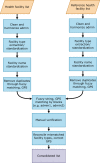A consolidated and geolocated facility list in Senegal from triangulating secondary data
- PMID: 38267460
- PMCID: PMC10808422
- DOI: 10.1038/s41597-024-02968-z
A consolidated and geolocated facility list in Senegal from triangulating secondary data
Abstract
Having a geolocated list of all facilities in a country - a "master facility list" (MFL) - can provide critical inputs for health program planning and implementation. To the best of our knowledge, Senegal has never had a centralized MFL, though many data sources currently exist within the broader Senegalese data landscape that could be leveraged and consolidated into a single database - a critical first step toward building a full MFL. We collated 12,965 facility observations from 16 separate datasets and lists in Senegal, and applied matching algorithms, manual checking and revisions as needed, and verification processes to identify unique facilities and triangulate corresponding GPS coordinates. Our resulting consolidated facility list has a total of 4,685 facilities, with 2,423 having at least one set of GPS coordinates. Developing approaches to leverage existing data toward future MFL establishment can help bridge data demands and inform more targeted approaches for completing a full facility census based on areas and facility types with the lowest coverage. Going forward, it is crucial to ensure routine updates of current facility lists, and to strengthen government-led mechanisms around such data collection demands and the need for timely data for health decision-making.
© 2024. The Author(s).
Conflict of interest statement
N.F., P.Y.L., and G.I. are paid employees of Gates Ventures. N.F., P.Y.L., and G.I. previously worked at the Institute for Health Metrics and Evaluation (IHME): September 2008–2011 and February 2013-June 2022 for NF; June 2014-September 2017 and January-June 2022 for P.Y.L.; and August 2014-July 2020 for G.I. N.F. reports funding from WHO between June and September 2019 for consulting unrelated to this work.
Figures


References
-
- McFarlane, T. D., Teesdale, S. & Dixon, B. E. Chapter 12 - Facility Registries: Metadata for Where Care Is Delivered. in Health Information Exchange (ed. Dixon, B. E.) 183–201 (Academic Press, 2016). 10.1016/B978-0-12-803135-3.00012-8.
-
- World Health Organization (WHO). Master facility list resource package: guidance for countries wanting to strengthen their master facility list: facilitator guide for the MFL training. (WHO, 2019).
-
- Noor AM, et al. Mapping the distribution and risk of epidemics in the WHO African Region/Cartographie de la distribution et des risques d’epidemie dans la Region africaine de l’OMS. Weekly Epidemiological Record. 2018;93:251–257.
Publication types
Grants and funding
LinkOut - more resources
Full Text Sources

